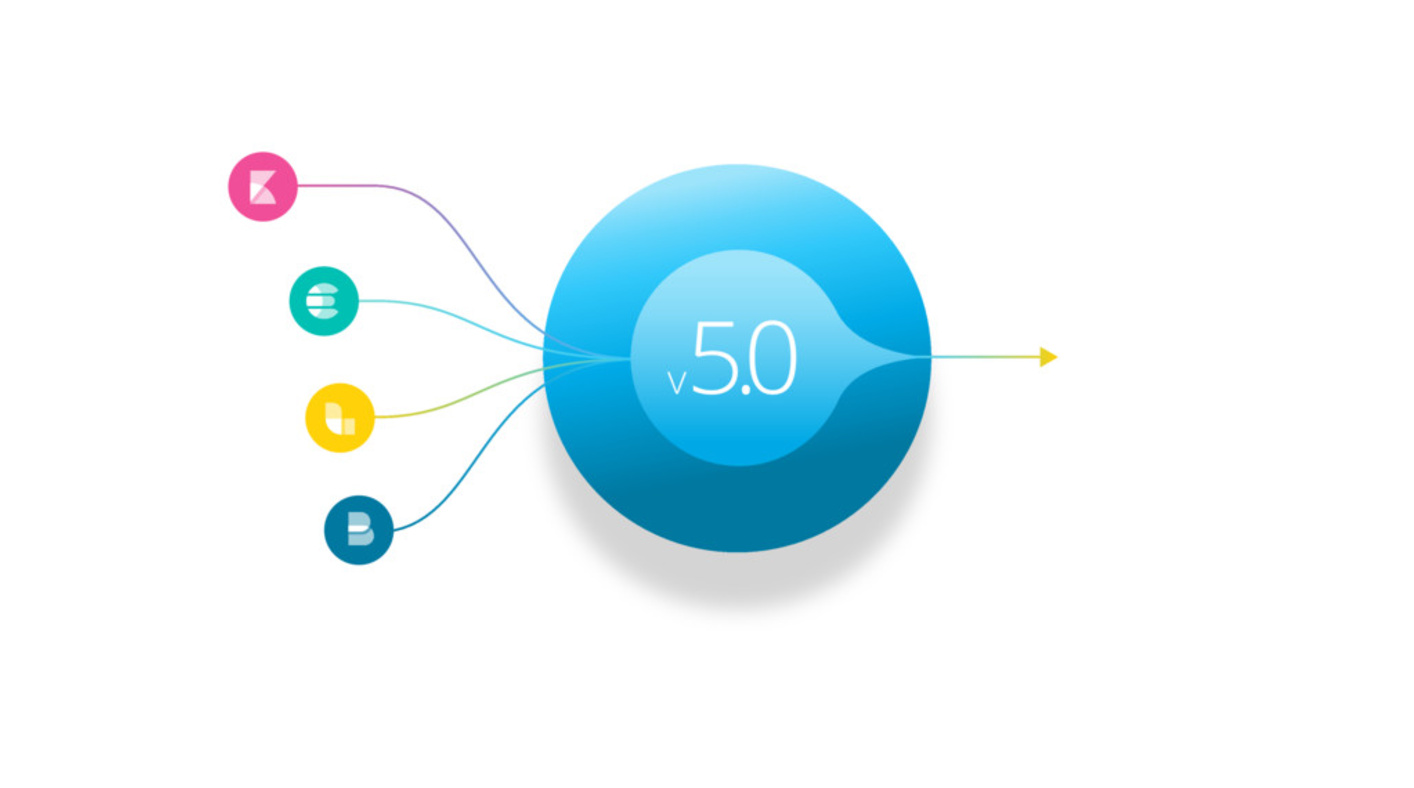$ ls ~yifei/notes/
Elasticsearch 上手教程
Posted on:
Last modified:
ES 家的几个产品版本不太统一,有的在 2.x,有的在 4.x,为了打包在一起卖,ES 家把 ES、Kibana、 Logstash 的版本统一成了 5.0 版本。写作时的版本是 7.x

大体上来说,7.0 之前的 ES 可以这样理解:
- 关系型数据库:Databases -> Tables of Rows -> Columns
- Elasticsearch:Indices -> Types of Documents -> Fields
Elasticsearch 集群可以包含多个索引 (indices),每一个索引可以包含多个类型 (types),每一个 类型包含多个文档 (documents),然后每个文档包含多个字段 (Fields)。 另外,在 ES 中,也常用 mapping 这个词,指的是字段到类型的映射,大概意思和 schema 相近。而且 mapping 可以嵌套, 也就是说一个 document 可以有其他的 document 作为 child.
但是需要特别注意的是:在 SQL 中,不同表中的列都是毫不相关的,而在 ES 中,同一个索引内, 不同 type 的同名 fields 就是同一个 fields。
- 索引(名词)如上文所述,一个索引 (index) 就像是传统关系数据库中的数据库,它是相关文档 存储的地方,index 的复数是 indices 或 indexes。
- 索引(动词)「索引一个文档」表示把一个文档存储到索引(名词)里,以便它可以被检索或者查询。 这很像 SQL 中的 INSERT 关键字,区别是,如果文档已经存在,新的文档将覆盖旧的文档。
- 倒排索引,传统数据库可以为特定列增加一个索引,例如 B-Tree 索引,来加速检索。 Elasticsearch 和 Lucene 使用一种叫做倒排索引 (inverted index) 的数据结构来达到相同目的。
重要更新, 在 ES 7.0 和之后的版本中,打破了这种设定,删除了 type,也就是说一个索引中
只有一个类型了----_doc. 如果想要有不同的类型,要么自己定义一个 type 字段区分,要么
就选择每一个索引都只存一种类型的 document. 如果你看到的教程还在讲 type, 或者 Python 的教程
还在使用 doc_type 参数,那么赶快别看了换个别的,新版本马上要把 doc_type 删掉了。
在 Elasticsearch 中,每一个字段的数据都是默认索引的。也就是说,每个字段专门有一个反向索引 用于快速检索。一个文档不只有数据,它还包含了元数据 (metadata)。几个必须的元数据节点是:
_index, 文档所在的索引_type, 文档代表的对象的类,ES 7.0 中已经删除了,需要的地方固定填写_doc。_id, 文档的唯一标识_version, 用于控制冲突,可以由外部指定,采用乐观锁
安装
因为 AWS 这些云厂商一直在吸开源血,所以 ES 默认产品现在需要使用自己的 brew tap 安装:
brew tap elastic/tap
brew install elastic/tap/elasticsearch-full elastic/tab/kibana-full创建索引和插入数据
Mapping 用来定义 ES 中文档的字段类型,如果使用 dynamic mapping, ES 就会在第一次见到某个 字段的时候推断出字段的类型。这时候就有问题了,比如,时间戳可能被推断成了 long 类型。所以, 一般我们会在创建索引的时候指定 mapping 的类型。
PUT http://localhost:9200/company
{
"settings": {
"number_of_shards": 1,
"number_of_replicas": 1,
// 指定文本分词
"analysis": {
"analyzer": {
"default": {
"type": "custom",
"tokenizer": "keyword",
"filter": "lowercase"
}
}
},
},
// 指定字段的类型
"mappings": {
"properties": {
"age": {
"type": "long"
},
"experienceInYears": {
"type": "long"
},
"name": {
"type": "text",
"analyzer": "analyzer-name" // 或者直接指定 ik_smart
}
}
}
}ES 中的类型有:boolean, binary, long, double, text, date 等。
- 如果需要存储 enum 类型的话,直接在 text 类型中指定
{"index": False}就好了 - date 类型可以自动识别一些日期格式,如时间戳,
YYYY-mm-dd等,也可以使用format指定。 - 使用 analyzer 指定文本类型的分词器
插入文档时需要注意,因为已经没有 type 这个概念了,所有 URL 中使用固定的 _doc 字段
POST http://localhost:9200/company/_doc/?_create
{
"name": "Andrew",
"age" : 45,
"experienceInYears" : 10
}更新数据
可以直接使用 PUT, 然后数据放在 {"doc": ...} 中就好了,然鹅,update_by_query 并不支持 doc.
Text Analyzer
众所周知,倒排索引的第一步就是要对文本进行一些预处理,尤其是分词。英文还好说,天然就是 分好的,而中文则需要一些特殊的处理。英文只需要做一些词形的变化,还原成原型,也就是 stem。 在 ES 中负责这些工作的部分叫做 Text Analyzer.
Text Analyzer 一般分为三个部分:
- Char Filter, 也就是处理一些字符
- Tokenizer, 也就是分词器
- Token Filter, 也就是处理一些词。添加同义词,抽取词干也会在这里进行
当文件被添加到索引和查询索引的时候都会调用 text analyzer.
为某个字段指定 text analyzer:
PUT my-index-000001
{
"mappings": {
"properties": {
"title": {
"type": "text",
"analyzer": "whitespace"
}
}
}
}为某个索引指定 text analyzer:
PUT my-index-000001
{
"settings": {
"analysis": {
"analyzer": {
"default": {
"type": "simple"
}
}
}
}
}使用 IK 分词
最常用的中文分词工具就是 IK 分词了,在 GitHub 上已经有一万个 Star 了,应该还是值得信任的。
VERSION=7.10.2
bin/elasticsearch-plugin install https://github.com/medcl/elasticsearch-analysis-ik/releases/download/v${VERSION}/elasticsearch-analysis-ik-${VERSION}.zip其中的版本号需要替换成对应的 ES 的版本号。
如果升级了 ES 的版本,会遇到Plugin [analysis-ik] was built for Elasticsearch version 7.9.2 but version 7.11.1 is running 这种错误,直接卸载升级插件就好了:
elasticsearch-plugin remove analysis-ik
elasticsearch-plugin install https://github.com/medcl/elasticsearch-analysis-ik/releases/download/v7.11.1/elasticsearch-analysis-ik-7.11.1.zipIK 为 Elasticsearch 增加了两个分词器:ik_smart, ik_max_word. 其中 ik_smart 会分出
较少的词,而 ik_max_word 会穷尽每一种方法分出尽量多的词。
比如:今天天气真好.
ik_smart会分成:今天天气,真好.ik_max_word会分成:今天天气,今天,天天,真好.
安装 IK 分词器之后需要重启 ES。
搜索
GET /[index]/_search
GET /bank/_search
{
"query": { "match_all": {} }, // 查询的条件
"sort": [
{ "account_number": "asc" } // 排序条件
],
"from": 10, // 用于分页
"size": 10 // 每页大小
}返回
{
"took" : 63, // 检索花费的时长
"timed_out" : false, // 是否超时
"_shards" : { // 关于检索的分片的信息
"total" : 5,
"successful" : 5,
"skipped" : 0,
"failed" : 0
},
"hits" : { // 命中结果
"total" : { // 命中结果数量
"value": 1000,
"relation": "eq"
},
"max_score" : null,
"hits" : [ {
"_index" : "bank",
"_type" : "_doc",
"_id" : "0",
"sort": [0],
"_score" : null,
// 检索到的文档内容
"_source" : {"account_number":0,"balance":16623, ...}
}, {
"_index" : "bank",
"_type" : "_doc",
"_id" : "1",
"sort": [1],
"_score" : null,
"_source" : {"account_number":1,"balance":39225, ...}
}, ...
]
}
}搜索中有很多参数可以调节:
track_total_hits. 默认情况下只有小于 10000 的时候结果才是精确的,因为统计有多少结果 是一个 O(n) 的操作。filter. 按照某些条件过滤结果。比如电商中,搜索衣服时候的尺码颜色等highlighter. 在搜索结果中节选出包含关键词的部分_source. 通过一个数组指定返回的字段。默认情况下是返回所有字段的。
查询字段
最简单的查询:
GET /_search
{
"query": {
"match": {
"message": "this is a test"
}
}
}match 会对文本进行分析,比如全部改成小写等。如果要使用完全匹配,可以使用 term
GET /_search
{
"query": {
"term": {"name": "john"}
}
}默认情况下,查询的字段是使用 OR 关系的,显然这不是我们想要的,可以指定为 and
GET /_search
{
"query": {
"match": {
"message": {
"query": "this is a test",
"operator": "and"
}
}
}
}match_all 用来读取所有文档:
GET /_search
{
"query": {
"match_all": {} // 这个参数永远为空
}
}组合查询
如果需要使用 OR/AND/NOT 那么需要使用 bool 子句:
- AND 使用 "must"
- OR 使用 "should"
- NOT 使用 "should_not"
比如说 round AND (red OR blue) 可以表示成:
{
"query": {
"bool": {
"must": [
{
"term": {"shape": "round"}
},
{
"bool": {
"should": [
{"term": {"color": "red"}},
{"term": {"color": "blue"}}
],
"minimum_should_match": 1
}
}
]
}
}
}一般来说,要实现 OR 的效果,还应该加上:minimum_should_match: 1, 表示 should 中的条件
至少要有一个成立。
删除所有数据
删除所有数据,但是保留索引的 mapping 结构。
POST: http://localhost:9200/index/_doc/_delete_by_query
{
"query": {
"match_all": {}
}
}搜索结果翻页
使用 from 和 size 两个参数可以翻页,但是这两个参数就和 SQL 里面的 limit 和 offset 一样, 页码越大,性能越低,因为他们其实就是傻乎乎的弄出所有结果来然后取中间。
除此之外,还可以使用 scroll api, 也就是让 ES 缓存住这个查询结果,每次都取一段。显然对于 ad-hoc 的用户搜索来说也是不适用的。
最后一种方法是使用 search_after, 其实就相当于 SQL 中使用 where id > $id, 然后每次查询都用 上次的最大 ID 就可以了。在 ES 中自然是取 sort 字段中每次查询的最大(最小)值。
GET my-index-000001/_search
{
"size": 10,
"query": {
"match" : {
"message" : "foo"
}
},
"search_after": [1463538857, "654323"], // 对应 sort 中的字段
"sort": [
{"@timestamp": "asc"},
{"tie_breaker_id": "asc"}
]
}搜索结果排序
默认情况下,搜索结果会按照计算出来的 _score 也就是和搜索 query 的相关度来排序,我们也可以通过自定义 sort 字段来指定排序规则。
GET /my-index-000001/_search
{
"sort" : [
{ "post_date" : {"order" : "asc"}},
"user",
{ "name" : "desc" },
{ "age" : "desc" },
"_score",
"_doc",
],
"query" : {
"term" : { "user" : "kimchy" }
}
}查询 DSL
ES 用 JSON 实现了自己的一套查询语句,基本上就是个 AST, 直接写就行了。子句分成两个:
- 查询子句
- 复合子句
复合字段
在 Elasticsearch 中每一个字段都可以作为数组存储,但是有两个问题:
- append 到数组的操作比较复杂
- 无法对数组中的元素进行去重,没有 unique 索引
查询倒是非常简单,直接用 . 分隔就好了:post.tags
所以,对于复杂的嵌套性数据,如文章的评论,最好不要使用这种方式存储,对于 tag 等简单数据尚可。
参考
- http://www.tianshangkun.com/2018/05/15/ElasticSearch%E7%9A%84%E6%90%AD%E5%BB%BA%E4%B8%8E%E6%95%B0%E6%8D%AE%E7%BB%9F%E8%AE%A1/
- https://segmentfault.com/a/1190000017215854
- https://www.elastic.co/blog/found-elasticsearch-mapping-introduction
- https://medium.com/@ashish_fagna/getting-started-with-elasticsearch-creating-indices-inserting-values-and-retrieving-data-e3122e9b12c6
- https://elasticsearch-py.readthedocs.io/en/master/api.html
- https://www.elastic.co/blog/phrase-Queries-a-world-without-stopwords
- https://www.elastic.co/guide/en/elasticsearch/reference/current/built-in-users.html#set-built-in-user-passwords
- https://stackoverflow.com/questions/16712642/elasticsearch-enum-field
- smartcn vs ik
- https://segmentfault.com/a/1190000017215813
- https://stackoverflow.com/questions/8140651/how-to-search-nested-objects-with-elasticsearch
- https://stackoverflow.com/questions/30308817/elastic-search-mapping-for-nested-json-objects
- https://stackoverflow.com/questions/51384829/how-to-append-to-an-array-in-elasticsearch-using-elasticsearch-py
© 2016-2022 Yifei Kong. Powered by ynotes
All contents are under the CC-BY-NC-SA license, if not otherwise specified.
Opinions expressed here are solely my own and do not express the views or opinions of my employer.
友情链接: MySQL 教程站